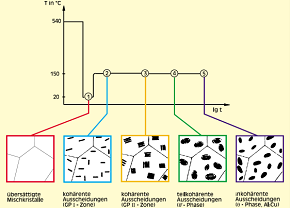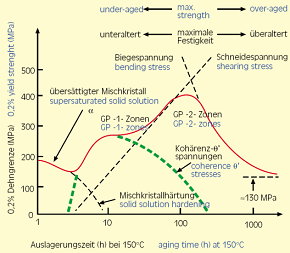Description
|
The strengthening in Aluminium-Copper alloys, caused by solid solution hardening, precipitate- and grain-boundary-strengthening, shall be investigated numerically by means of molecular dynamics simulations. The development of algorithms to perform the simulations and for the analysis of the simulation results is essential for this purpose. The aims of these simulations are fundamental findings concerning dislocation/precipitate interactions, residual stresses around the precipitates, the inverse Hall-Petch effect and crack propagation.
Solid solution hardening, precipitate- and grain-boundary strengthening play an outstanding role for the technical application of Al alloys. In this project the strengthening will be analysed by means of molecular dynamics simulations. For this purpose the molecular dynamics code IMD, which has been developed in the context of SFB 382, and EAM (Embedded Atom Method) potentials for Al-Al, Cu-Cu and Al-Cu will be applied. At first computer programs will be developed which enable the creation of appropriate initial structures, i.e. Al single crystals, Al-Cu solid solutions, crystals with so-called Guinier-Preston(GP) zones GP-I (coherent disc shaped Cu precipitates of 5 nm diameter and monoatomic thickness) and accordingly GP-II (coherent discs of 20 nm diameter and and 3 nm thickness) in the Al matrix, as well as polycrystals with grain boundaries, see Figure 1.
|
Hereupon edge or screw dislocations will be inserted in the structures and the restraint of dislocation motion - in particular under external load - will be analysed by means of molecular dynamics simulations. The calculations require large atom numbers and long computing times, furthermore they make high demands on computer graphics.
The simulations aim in a comprehension of the influence of solid solution-, precipitate- and grain-boundary-strengthening on the macroscopic yield strength, see Fig. 2.
Particularly fundamental findings concerning dislocation/precipitate interactions, residual stresses around the precipitates, the inverse Hall-Petch effect (and the herewith aligned maximum of strength in nanocrystalline Al materials) and crack propagation are expected.



